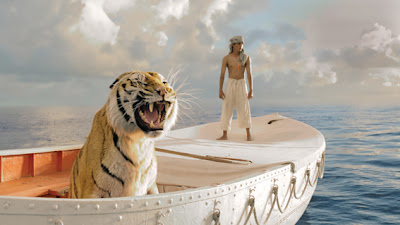Life of Pi. Rated PG (mild survival themes). 127 minutes. Directed
by Ang Lee. Screenplay by David Magee. Based on the novel by Yann Martel.
Verdict: A curiously uneven but visually ravishing
adventure.
As a spiritually uplifting
rumination on the undeniable existence of an almighty creator, Life of Pi delivers a good many pleasures. At its core is the
unlikely friendship between a young man, Pi (an extraordinary debut from Suraj
Sharma), and a tiger named Richard Parker (the CGI creation of visual effects
company Rhythm and Hues) who find themselves adrift in a lifeboat after the
ship on which they are travelling is lost at sea during a fierce storm. As the
two survivors learn to co-exist, the bountiful and perilous wonders of the
ocean are revealed in sequences of ravishing visual splendour, flawlessly
photographed by cinematographer Claudio Miranda (Fight Club,
TRON: Legacy, The Curious
Case of Benjamin Button).
If Magee’s (Finding
Neverland) screenplay takes a
little too long to set sail, the flashback sequences – as the adult Pi (Irrfan
Khan) recounts his tale for the benefit of a curious writer (Rafe Spall) – have
a surprisingly soul-less quality to them. It’s almost as though Pi only
survived a particularly gruelling trip to the supermarket as opposed to the
terrifying ordeal of 227 days at sea with only a ravenous tiger for company.
It’s the unevenness of the present day sequences when compared to the fantastic
main game that lends the film an occasionally jarring lack of cohesion.
Book-ending the
astonishing survival sequences that have long been considered un-filmable was
never going to be easy, but Lee’s (The Ice Storm, Crouching Tiger, Hidden Dragon, Brokeback Mountain) patient study of the developing friendship
between Pi and the tiger on the high seas is engrossing. The sequence where
Richard Parker leaps overboard in search of prey and struggles to get back into
the lifeboat, clinging to it with his claws through the night, is deeply moving
– and the full screen close-up of the desperate tiger’s face staring up at his
potential human saviour is the shot of the film.
Like Martel’s
award-winning novel, the film will inspire many conversations about its true
meaning and significance. If the novel’s famous conclusion that questions the
authenticity of Pi’s tale is a little too neatly accounted for, there is little
doubt that this extraordinarily beautiful film (and one that should really be
seen in 3D) will linger in your memory for a long time after you have
experienced it.
This review was commissioned by the Geraldton Newspaper Group.

No comments:
Post a Comment